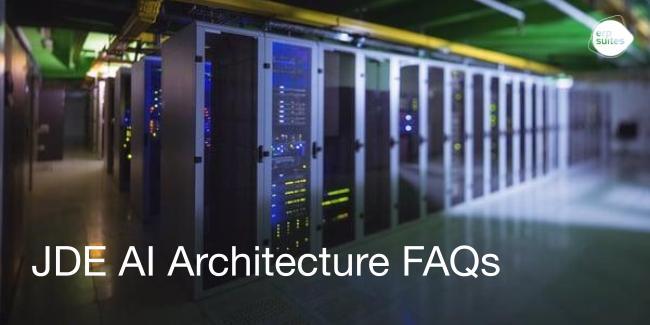What to Consider When Budgeting for AI Projects
June 11th, 2024
6 min read
.png?width=960&height=540&name=Blog%20Images%20(44).png)
From machine learning to large learning models to Generative AI, the power of artificial intelligence is not to be underestimated. Especially when it comes to the workplace, where the possibilities are endless: automating tedious tasks, gaining deeper insights from your data, and making smarter business decisions. But there’s a problem. When you think about budgeting for an AI project, you feel overwhelmed. The costs seem unclear, and you're not sure where to start. You worry about making a wrong move and wasting your company's resources. This is a common challenge faced by many professionals like you, who want to embrace AI but are cautious about the financial implications.
Our team at ERP Suites has guided businesses through successful digital transformations. With nearly 20 years of experience and hundreds of companies coached, we understand the intricacies of budgeting for AI. This article is here to help you.
By the end, you’ll have a clear understanding of the infrastructure and tools needed when creating a budget for an AI project. We’ll walk through everything step by step, making sure you’re informed and confident about taking the next steps in your AI journey. You’ll gain insights into cloud-based solutions, essential software, data management, hiring practices, and more. Our goal is to demystify the budgeting process so you can move forward with your AI ambitions without the fear of hidden expenses or unforeseen challenges.
Cloud-Based Infrastructure vs. Traditional Hardware
One of the first decisions you'll need to make is whether to go with a cloud-based infrastructure or traditional hardware for your AI project. In the past, setting up an AI project meant investing in expensive, high-maintenance hardware. This often involved significant upfront costs and ongoing maintenance that could quickly become burdensome. Today, cloud services like Oracle Cloud Infrastructure (OCI) and Amazon Web Services (AWS) offer a more accessible and cost-effective alternative.
Benefits of Using OCI or AWS for AI Projects
Cloud-based solutions are generally easier to manage and scale. With OCI or AWS, you pay for what you use, which means you can start small and expand as your needs grow. This flexibility is particularly beneficial for businesses that are just beginning their AI journey and want to avoid large initial investments. Plus, these platforms offer robust security and compliance features, ensuring your data is safe and regulations are met. They handle updates and maintenance, so your team can focus on leveraging AI to drive business value instead of managing infrastructure.
Essential Software and Tools for AI Budgeting
To get your AI project off the ground, you'll need specific software and tools. These tools are designed to help you manage data, build models, and generate insights without requiring extensive manual effort. Let's break down some of the most important ones, which will form the backbone of your AI initiatives.
Budgeting and Forecasting with E1
One , which helps with budgeting and forecasting. It allows you to plan your expenses and predict future financial performance, which is crucial for managing an AI project. With E1, you can create detailed budgets, track spending, and make informed financial decisions. This ensures that your AI project stays on track financially and that you can justify the investment to stakeholders.
Oracle ADW: Cost-Effective Data Warehousing
Another key component is the Oracle Autonomous Data Warehouse (ADW). This tool is cost-effective, especially for projects that don’t require handling massive volumes of data. ADW includes Oracle Machine Learning (OML), which offers sophisticated modeling tools, making it easier to project, forecast, and balance accounts. By using ADW, you can store and analyze your data efficiently without incurring high costs associated with traditional data warehousing solutions.
Advanced Modeling with Oracle Machine Learning (OML)
OML integrates Python and R interfaces, providing powerful tools for building and refining your AI models. This means you can create detailed financial projections and analyze complex data without needing to invest in separate modeling software. The built-in capabilities of OML allow you to perform advanced analytics and machine learning tasks directly within your data warehouse environment. This integration simplifies the workflow and reduces the need for additional tools and training.
Data Acquisition and Management
Data is the backbone of any AI project. Managing and acquiring this data effectively is crucial. Poor data management can lead to inaccurate insights and ultimately undermine the success of your AI initiatives. Ensuring that your data is well-organized and accessible is the first step towards leveraging AI effectively.
Utilizing Native JDE Databases
You likely already have a lot of data in your existing systems. Using your native JD Edwards (JDE) database, you can create data pipelines that feed into your ADW. This ensures that your AI tools have access to the necessary data for analysis and decision-making. By leveraging your existing databases, you can save time and resources while ensuring that your AI models are built on accurate and comprehensive data.
Building Data Pipelines to ADW
Data pipelines are essential for moving data from your transactional databases to your data warehouse. Using tools like REST APIs or database transactions, you can efficiently transfer data to your ADW, enabling real-time analysis and reporting. These pipelines automate the flow of data, reducing manual intervention and the risk of errors. They also allow you to keep your data warehouse up to date with the latest information, which is crucial for timely and accurate AI insights.
The Role of ETL and DTS in Data Management
ETL (Extract, Transform, Load) and DTS (Data Transformation Services) are processes that help in data migration. They ensure that your data is correctly formatted and transferred to where it’s needed, such as from your JDE database to your ADW. These tools help streamline data management, making it easier to scale your AI project. ETL and DTS processes can handle complex data transformations, ensuring that your data is clean and ready for analysis. This is critical for maintaining the quality and reliability of your AI outputs.
Hiring and External Expertise for AI Projects
Implementing AI in your business often requires specialized knowledge. You may need to hire external experts to help. These experts bring in the technical skills and experience necessary to navigate the complexities of AI, ensuring that your project is set up for success from the start.
The Need for Technical-Financial Experts
For AI projects, having someone who understands both finance and technology is invaluable. These technical-financial experts can bridge the gap between your IT department and financial goals, ensuring that your AI project aligns with your business needs. They can help translate technical requirements into financial terms, making it easier to justify and manage the investment. By having such experts on your team, you can ensure that your AI initiatives are both technically sound and financially viable.
Managed Services
Depending on your resources and expertise, you might consider managed services. These services allow you to outsource parts of your AI project, from setup to maintenance, making it easier to manage and implement. By leveraging these services, you can reduce the burden on your internal team and ensure that your project is handled by professionals with the right expertise.
Integration and Implementation of AI Tools
Integrating AI tools into your existing systems doesn’t have to be complicated. With the right approach and tools, you can seamlessly incorporate AI into your business processes, enhancing efficiency and decision-making.
Simplifying Data Movement with ETL and DTS Services
Using ETL and DTS services simplifies the process of moving data. These tools can handle the heavy lifting, ensuring your data is where it needs to be for analysis and reporting. They automate the extraction, transformation, and loading of data, reducing the manual effort required and minimizing the risk of errors. By streamlining data movement, you can focus on leveraging the insights generated by your AI tools.
JD Edwards Orchestrator for Efficient Data Integration
The JDE Orchestrator is another valuable tool for integration. It helps automate data movement, making it easier to integrate AI tools with your existing systems without extensive manual effort. The Orchestrator allows you to create automated workflows that handle data integration tasks, ensuring that your data is always up to date and ready for analysis. This tool simplifies the integration process, reducing the time and effort required to incorporate AI into your business.
Maintenance, Upgrades, Compliance, and Security
Maintaining and upgrading your AI tools is crucial for long-term success. Ensuring that your systems are secure and compliant with regulations is also essential to protect your data and maintain trust.
The Role of Cloud Computing in Maintenance and Upgrades
One of the significant advantages of using cloud-based services like OCI or AWS is that maintenance and upgrades are handled by the service provider. This means you don’t need to worry about hardware maintenance or software updates, freeing you to focus on using the tools. Cloud providers regularly update their services with the latest features and security enhancements, ensuring that your AI tools remain cutting-edge and secure. This reduces the burden on your IT team and allows you to take advantage of new capabilities as they become available.
Ensuring Compliance and Security in AI Projects
Security and compliance are always a concern. Cloud providers like OCI and AWS offer robust security measures, ensuring that your data is protected and that you meet any regulatory requirements. These platforms provide comprehensive compliance certifications, making it easier to adhere to industry standards and regulations. By choosing reputable cloud services, you can ensure that your AI project is secure and compliant, reducing the risk of data breaches and regulatory issues.
Cost Optimization and ROI Analysis
Understanding the costs and potential return on investment (ROI) is critical for any AI project. Properly managing these aspects ensures that your project delivers value without exceeding budget constraints.
Upfront Costs vs. Recurring Expenses
One benefit of cloud-based AI tools is that you can shift from capital expenditures to operational expenditures. Instead of a large upfront cost, you pay a recurring fee, making it easier to manage your budget. This approach allows for more predictable financial planning and reduces the need for large, one-time investments. It also provides flexibility, as you can adjust your usage and costs based on your evolving needs.
Cost Savings Through Cloud-Based Solutions
Cloud solutions can offer significant cost savings. By only paying for what you use and avoiding the need for expensive hardware, you can reduce your overall expenses while still accessing powerful AI tools. This pay-as-you-go model ensures that you only incur costs when you actively use the services, making it a cost-effective option for businesses of all sizes. Additionally, cloud providers often offer various pricing tiers and discounts, further enhancing the affordability of their solutions.
Taking the Next Steps Towards Your AI Project
Budgeting for an AI project doesn’t have to be daunting. By understanding what goes into an AI project, how to leverage the right tools, and integrate them effectively, you are better prepared to create a budget and cost estimate for said project – and prepared for success. Let’s get a call on the books to take the next steps on your AI project journey.
Leyla Shokoohe is an award-winning journalist with over a decade of experience, specializing in workplace and journalistic storytelling and marketing. As content manager at ERP Suites, she writes articles that help customers understand every step of their individual ERP journey.



.png?width=650&height=325&name=Blog%20Images%202_1%20(4).png)
.png?width=650&height=325&name=Blog%20Images%202_1%20(5).png)
.png?width=650&height=325&name=Blog%20Images%202_1%20(3).png)
.png?width=650&height=325&name=Blog%20Images%202_1%20(2).png)
.png?width=650&height=325&name=Blog%20Images%202_1%20(1).png)
.png?width=960&height=540&name=Blog%20Images%20(96).png)

.png?width=960&height=540&name=Blog%20Images%20(90).png)
.png?width=960&height=540&name=Blog%20Images%20(88).png)
.png?width=960&height=540&name=Blog%20Images%20(87).png)
.png?width=960&height=540&name=Blog%20Images%20(86).png)
.png?width=960&height=540&name=Blog%20Images%20(85).png)
.png?width=960&height=540&name=Blog%20Images%20(83).png)
.png?width=960&height=540&name=Blog%20Images%20(82).png)
.png?width=960&height=540&name=Blog%20Images%20(80).png)